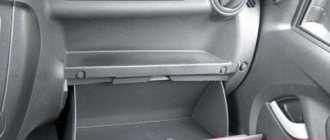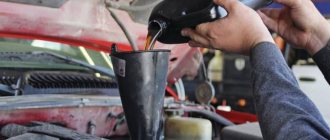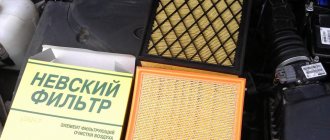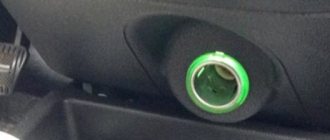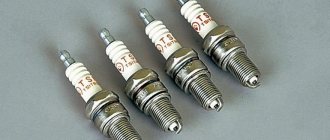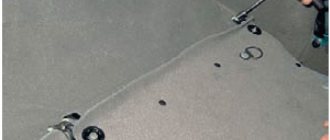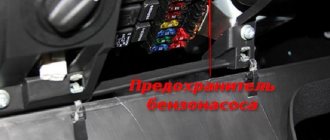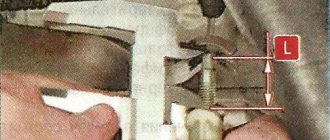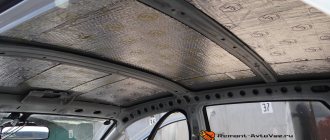Water flows into the car, what to do and what are the reasons:
If you have water leaking into your car, you need to deal with it quickly because of the many serious problems it can cause. If water sits in your car's carpet for too long, mold can grow and cause unpleasant odors. Other problems may include corroded pin connectors, computer malfunctions, faulty sensors, rust, and high humidity inside the car causing your windows to fog up.
Where does water come from inside a car?
Water under the carpet in the car is not the only sign of a water leak. If you have an idea where the water is going, check for watermarks, stains, or even signs of rust. Carefully inspect the connectors for corrosion and check the brackets for rust stains. You'll be amazed at what you find when you look for it.
I've always said, "A mechanic's best tools aren't in their toolbox, they're in their heads." Water leaks are difficult to pinpoint, but once you determine where exactly the water is coming from, you can access the problem area and fix it.
Leaking windshield
The main cause of water leaks in a car is poor windshield installation. If you recently had your windshield replaced, take a look at this option. I'm not trying to be disrespectful to windshield replacement companies, it's just that some companies hire people who just don't care and will cut out the old windshield and put a new one in without properly preparing the landing site for the new windshield.
If a professional is replacing the windshield, it will take at least two hours, plus then time for the various weather stripping sealants to dry. It takes time to remove the moldings, cut the windshield, trim away the old urethane so the new windshield sits flat, touch up any scratches in the paint during the removal process, prime the glass, and install a nice new seal.
If your "professional" replaced the glass in just 15 minutes, his or her work may not only be the cause of the water leak, but also a safety issue. In the event of a car accident, you could fall through an improperly installed windshield and suffer serious injuries. I'm good friends with a guy who owns his own windshield repair company, and I see and hear horror stories, so I'm writing to you from personal experience.
Water leaking into the interior through welded seams
Body seams are the second leading cause of water leaks in your car. Seams that were not properly sealed at the factory, or seams that were torn as a result of a car accident, usually cause mysterious water leaks. Finding such a leak can be very difficult and time-consuming.
Once you discover a leaking seam, I recommend using special high-quality sealants in the problem area. This is the same thing that automakers use at the factory to seal all the seams in the car body after they are welded. One of the reasons I like using this sealant is that it cures (dries and bonds) in about 30 minutes, so you won't have to wait long between water tests. However, if you can leave the car overnight after sealing it, the sealant will completely adhere to the seams of the body, and you will not then have a seam tear due to the body flexing before the sealant dries completely.
How to understand where it is leaking from?
These are the pro tips. If there is a suspicion of a leak, a wet floor or high humidity in the cabin, you must do the following:
remove decorative elements of the interior from the side of the likely leak (mats, plastic linings, door cards, parts of the floor, etc.);
wait for a heavy downpour/borrow a friend’s Karcher/stop at a car wash;
When watering the car generously, carefully monitor where it is leaking from.
That's it. Have you encountered water in rapids? Voting at the top.
Not every car owner knows about the existence of drainage holes in his car. And those who know do not always check them, thinking that it is a waste of time. It is necessary to understand what drainage holes are in the car body and what they serve.
Drainage holes in the car body serve to remove moisture that enters the internal cavities of the body. Photo: largusladaclub.ru
Water test your car for external leaks
Finding an entry point is the first step to preventing rainwater from entering your vehicle. This investigation takes a lot of time, but there are some things you can do yourself. You need to physically see where the water is entering the machine, not just where it is moving along a panel or seam.
To check your car, pour water on it: start at a low point and work your way up to the roof. If you determine that water is leaking into the bottom of the windshield, there is no need to go higher with a water test until you have fixed that first slight leak.
Advice from “old school” drivers
From the experience of owning a VAZ-21099, I can say that condensation in the trunk appears due to rubber carpets that do not allow air to circulate well. This is especially noticeable when the car is stored in a garage for a long time. When I leave my Granta in storage for a long time in the garage, I even take out the interior mats. All January holidays Grant costs separately, and rugs separately.
Today I picked up a rubber mat and was stunned by the amount of water that the carpet absorbed. White spots were also visible - mold began to form:
I removed the plastic above the threshold and pulled up the carpet:
Started wiping the water:
Of course, I cut out the insulation under the carpet into pieces as much as I could - it needs to dry.
I started pouring water on the glass to detect a leak, poured it here:
I found a trickle of water in the cabin:
Then it seemed that it was leaking from the elastic band that seals the cord:
Having looked closely, I realized that I was mistaken and, after pouring water for the 100th time, I ran up to see where it was leaking and found a place: (without an assistant who will pour water, don’t even get down to work - it’s difficult)
Water dripped directly onto the rubber band, and from the rubber band under the insulation and onto the metal floor at the driver’s feet, so at first it seemed like it was dripping from the rubber band.
I started looking for where it was pouring from, and even took off the strut cover:
I remembered that on the forum some people wrote that there was a leak above the mirror near the windshield - I checked the norm.
I took off the locker and checked the notorious rubber band, which was also causing some people to leak water:
But it turned out not to be the rubber band.
Then I remembered that someone had coated some kind of joint under the toad of the wiper gear motor. I took off the toad and started looking. Having recognized the bend that I had read about in one post on the eve of the repair, I started pouring water on it:
This is where it flooded from! To be honest, I didn’t go anywhere until I remembered the bend with the joint described in the post.
There was no sealant on hand to test the hypothesis. Tomorrow I will update the post with the final result on the bend and joint)))
Arriving home, I found the post I had read www.drive2.ru/l/7134534/ and imagine my surprise that the place where it flows into the interior is the same as mine (when I was flipping through before the repair, I didn’t pay attention to those windows in the red square: ca. d-cd.net/243a3b2s-960.jpg the author thought that the seam was leaking)))) Also, the place where the water flowed in (the bend with the joint) coincided.
Tomorrow I’ll still miss the mark and make sure for sure.
To be honest, I was exhausted, it was normal outside, it got dark on top of that + it was snowing and I had the frill removed and the door was swinging open and the snow had already started to land on the previous one)))
I won’t say hello to the plant, and so they know that their products will only be bought by those who have not yet messed around with AVTOVAZ’s products, or by a person who likes to fool around, or by someone who has not yet tasted all the delights of AvtoVAZ repairs))))
Of course, an incredible desire appeared to take out a new car on credit.
Once again, looking at my logbook: www.drive2.ru/r/lada/839787/logbook/ I understand that this is overkill. Although some do more with the car.
PS: I wanted to just ride, but it doesn’t work out - I have to constantly repair something.
I applied sealant to everything; you can’t really get to the joint without removing the wing:
It still leaks into the cabin, I already covered the glass where it was watered))) - it didn’t help.
It became clear that water was leaking somewhere between the wing and the body at the junction; I did not want to remove the wing.
A European window worker I knew asked what I was doing, asked him for some mounting foam and “boomed” - there are no leaks!:
PS2: If you open the door, you can see a bit of foam - I inserted paper into it to smooth out the bulging))) I put on a plastic cover - you can’t see what’s foamed at all, when selling the car, I don’t care what they say, the main thing is that it’s dry)))
I used a hairdryer to dry the insulation today. I put the cut out insulation on the battery and will put it in place later while I’m riding without the sill cover, so that I can lift it up at any time and see if there is water or not.
He pointed around where the foam was pouring from above. He poured water into the same place, then it seeped into some gap and flowed out through the oval into the car, the oval is located just above the rubber band with the wire for the turn signal:
Price tag: 0 ₽ Mileage 70000 km
Water flows into the car interior
An unpleasant musty smell in the trunk can be caused by water getting around the taillights or trunk lid after rain. If you can determine where exactly the water is leaking, you can fix it in a timely manner.
How to check a sunroof for leaks
Poorly or improperly installed seals are another leading cause of water leaks in your car. Everything from your sunroof to your roof rack system, if not installed properly and sealed, will result in you having water inside your car.
If you have a sunroof, check the drain. The hatches are leaking! That's why the sunroof is factory installed with a built-in pan with four drain holes, one in each corner of the sunroof. Sometimes these drain tubes become disconnected or clogged, causing water to leak into the vehicle. Locating drains and making sure they drain properly can take some time because they tend to get buried in fenders and body panels, but it's time well spent. The shortest route to detecting drains is to fill the manhole pan with water and watch where it goes when it drains. Typically, it will spill in the front and rear of the car.
Evaporator drain location (on most vehicles)
Leaks from inside the car
Some leaks into the passenger compartment occur when it has not even rained and involve fluids created by the vehicle's cooling or heating systems.
Air conditioner drain clogged
When air conditioners remove moisture from the air inside the car, they collect a lot of water that needs to drain out of the car. Water dripping from the air conditioner drain onto the ground is completely normal. Water does not drip onto the floor of the car from the air conditioner. If you haven't had any rain and you have a water leak on the passenger floor, check your A/C drain or evaporator drain, it may be clogged or disconnected. Debris is sucked into the evaporator from the outside and sometimes clogs the drain tube. A temporary quick fix for this problem is to apply compressed air to the drain tube located under the car, but eventually you will have to remove the evaporator and clean out the debris.
What to do if there is little moisture
Of course, it is better to prevent the appearance of moisture in the car interior than to deal with it later. Motorists who pay attention to car care in order to avoid unpleasant consequences are no less concerned about maintaining dryness than replacing consumables.
It is also important to regularly monitor the integrity of the insulating materials, because the seals wear out over time and can let water in from the outside. In case of wear, it is better to replace the insulation immediately.
In summer, you can easily provide conditions for quickly removing moisture; to do this, simply open the windows or doors so that warm air flows circulate well. If the car is equipped with a climate control system, then in any bad weather you can organize a suitable microclimate in the cabin. The “Window Defrosting” option will help get rid of excess humidity. Of course, you should not only brush snow off your clothes and shoes when getting into the car, but also use the right mats so that moisture doesn’t have a chance in the first place. In winter, you should not use textile car mats; rubber ones are better for this period, since they are easy to remove water from. By leaving your car in a heated garage with good ventilation, you don’t have to worry about the accumulation of moisture in the cabin. Drying will not be difficult even in winter if the room is well ventilated, since the water evaporating from the heat will not settle as condensation. So, if you leave the windows or car doors open in such a garage, the problem will be solved spontaneously.
It is not always possible to provide ideal conditions for car maintenance, and this is where many car owners are faced with the accumulation of moisture in the interior, subsequently wondering how to dry the car interior under the mats. A little moisture is not as big a problem as serious wetting of the upholstery and flooring, which requires special efforts to eliminate. First of all, you should get rid of the main water by blotting the accumulation areas with any of the moisture-absorbing materials, for which dry rags, newspapers, disposable towels, diapers and other similar things that are not difficult to find are suitable. Car mats should be removed, washed and dried thoroughly. Those who have already dried rugs in winter know firsthand that the process takes much more time than in the warm season, so it is necessary to provide appropriate conditions for drying; in the cold it will not be possible to complete the task properly. Next, the carpet is raised, and most of the moisture is removed from it and the bottom using absorbent agents to facilitate subsequent, more thorough drying. Rugs or carpeting that have contained antifreeze or other chemicals require careful removal of the composition from the surface.
Motorists often use silica gel or ordinary salt to dry the interior under the mats. When choosing this option, you should not forget about the subsequent cleaning of granules and particles, for which you will need a powerful vacuum cleaner. In addition, toilet paper is often used, which also absorbs moisture well, for which it is laid out on a wet surface and changed as it gets wet. If the car is not so critically wet and there are no puddles under the rugs, drying it will not take much time and effort. In dry weather in the summer, the simplest solution is to remove the car mats and leave the car with the windows and doors open in the sun. In a few hours the problem will be resolved without your further participation. In winter, warmth and ventilation should be provided. An effective option is to use a heat gun or hair dryer. You should act carefully so as not to get burned or cause a fire. A stove and air conditioner, used in tandem with each other, will also cope with the task adequately. Having turned on the heater to blow the feet and the air conditioner to recirculate, the car doors should be closed. When the interior heats up, the water will begin to evaporate, and the vapors will not settle due to air ventilation.
Leaking heater radiator
Another possible cause of wet carpet, especially in the front of the car when it is not raining, is a leak from the interior heater core. Car heaters circulate coolant through the dashboard area to heat the car, and if there is a leak inside the cabin heater, coolant can drip onto the floor.
Let's share information
I hope this has given you some insight into water leaks and some ideas on where to start. If you have a question about water leaking in your car, please leave it in the comment box below and I will answer it as soon as possible. And also tell your stories of how you overcame this ailment in your car, if, of course, it occurred to you.
